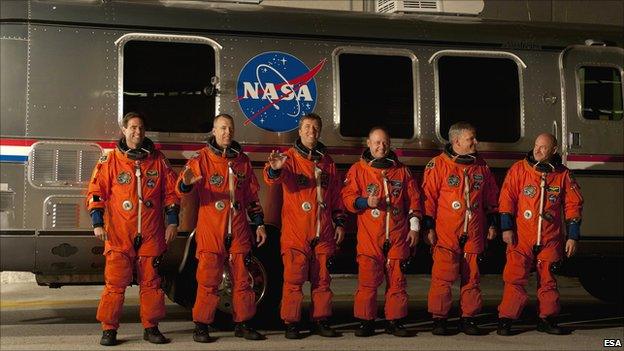Shuttle Endeavour launches one last time
- Published
The shuttle soared into the sky over the Kennedy Space Center
The US space shuttle Endeavour has launched on its final mission.
Its thunderous rise into a bright but cloudy morning sky over the Kennedy Space Center in Florida was watched by hundreds of thousands of spectators.
Among them was Endeavour commander Mark Kelly's wife, Gabrielle Giffords, the Arizona politician shot in the head by a gunman in January.
Doctors were satisfied enough with her recovery to allow her to travel to Kennedy to see her husband's departure.
"This mission represents the power of teamwork, commitment and exploration," the commander said in a radio call to launch controllers moments before lift-off. "It is in the DNA of our great country to reach for the stars and explore. We must not stop."
Endeavour cleared the pad just after 0856 local time (1256 GMT; 1356 BST).
It is now on a path to rendezvous with the International Space Station (ISS) on Wednesday.
The ship will deliver a $2bn particle physics experiment, known as the Alpha Magnetic Spectrometer (AMS), and a tray of critical spare parts.
On Endeavour's return, the only active ship left in the US space agency's (Nasa) shuttle fleet will be Atlantis.
It should undertake its final mission sometime in in July.

Mark Kelly (far right) and crew greet the crowds before boarding space shuttle Endeavour
"Today's final launch of Endeavour is a testament to American ingenuity and leadership in human spaceflight," Nasa Administrator Charles Bolden said in a statement.
"As we look toward a bright future with the International Space Station as our anchor and new destinations in deep space on the horizon, we salute the astronauts and ground crews who have ensured the orbiter's successful missions.
"The presence of Congresswoman Gabrielle Giffords at the launch inspired us all, just as America's space programme has done for the past 50 years."
On completion of the 30-year shuttle programme, America will use Russian Soyuz capsules to fly its astronauts to the ISS.
A number of US national commercial carriers are expected to enter into service around the middle of the decade.
Nasa will then buy seats in these astronaut "taxis". The arrangement will represent a major change in the way the agency does business. No longer will it own the vehicles it uses to go to low-Earth orbit.
This servicing plan should free up resources for Nasa to build an astronaut Space Launch System capable of travelling beyond the station, to the Moon, asteroids and to Mars.
Endeavour was built to replace the Challenger ship which was lost, along with her crew of seven, in a catastrophic accident in 1986.
This final flight is the vessel's 25th overall, having already clocked a cumulative distance in space of 166 million km - an expanse just greater than that which divides the Earth and the Sun.
Notable highlights in the ship's career have included the first construction mission to the ISS by a US orbiter, and the first servicing mission to the Hubble Space Telescope. The latter carried up the equipment to correct the flaw in the observatory's vision, enabling it to take breathtaking images of the cosmos.
Nasa is hoping the payload inside Endeavour for its final mission will deliver equally astonishing science.
The Alpha Magnetic Spectrometer (AMS) has taken 17 years to prepare for launch. It has been constructed by an international collaboration of researchers across 16 nations.
The machine will be fixed to the top of the ISS where it will undertake a comprehensive survey of cosmic rays.
These are the high-energy particles that are accelerated in Earth's direction from all corners of the cosmos.
Scientists hope that in characterising these particles they can address similar sorts of questions to those pursued in particle accelerators in Earth laboratories - how did the Universe come into being and how is it constructed?
But AMS principal investigator Professor Sam Ting told BBC News his space experiment would explore domains beyond the reach of ground technology.
"The highest energy particles are from the cosmos," he said. "No matter how large the accelerator you build on Earth, you cannot compete with cosmic rays." These particles are absorbed by the atmosphere and the only way to study them properly is to get into orbit, he added.
The AMS machine will:
look for clues to the nature of "dark matter", the material that shapes galaxies and makes up most of the mass of the Universe
hunt for complex antimatter, which might hint at the existence of stars and planets made from material that is a mirror of the matter in normal stars and planets
try to catch strangelets, or strange matter, which is built from a slightly different mix of sub-atomic particles to that of normal matter
characterise the space radiation environment so that the dangers for astronauts and satellites of being in space are fully comprehended
Kelly's crewmates on Endeavour's final mission are pilot Greg Johnson and mission specialists Mike Fincke, Drew Feustel, Greg Chamitoff and Roberto Vittori of the European Space Agency.
This is the first shuttle flight for Fincke and Vittori, although they are both very experienced astronauts having flown a number of Soyuz missions to the ISS. Indeed, on his return, Finke's cumulative time spent in orbit will be 381 days - a record for an American.
Vittori becomes the last international astronaut to fly aboard a shuttle.
- Published16 May 2011
- Published27 April 2011
- Published29 April 2011
- Published1 May 2011
- Published10 May 2011